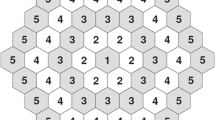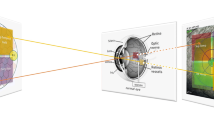Abstract
Background
Age-related macular degeneration (AMD) is one of the major causes of progressive and debilitating visual impairment in developed countries and has become a growing health and social issue that needs to be addressed. Imaging techniques and functional tests are useful to assess the degree of macular dysfunction and AMD progression. However, given the slow progression of the disease, it is necessary to identify which techniques are more sensitive for the diagnosis and monitoring of patients with AMD.
Purpose
To study changes observed with both imaging techniques and electrophysiological tests in dry AMD-diagnosed patients during 2 years in order to identify the most sensitive technique.
Methods
Fundus photography, OCT (macular thickness and number of drusen), Pattern VEP (P100 wave), Pattern ERG (P50 wave) and multifocal ERG (central rings) were carried out in 30 patients that were diagnosed with dry AMD in both eyes. The tests were repeated 1 and 2 years later.
Results
No statistically significant changes were observed in visual acuity or in the severity of the disease throughout the study. OCT showed an increase in the number of drusen, as well as in macular thickness. As for the electrophysiological techniques, no significant changes were observed throughout the study in Pattern VEP or Pattern ERG. mfERG showed significant alterations. Statistical analysis showed that mfERG is more efficient in detecting changes throughout the experimental period.
Conclusions
OCT and mfERG are useful in the diagnosis and monitoring of dry AMD patients, whilst mfERG is the most sensitive technique to study the progression of this disease in short periods of time.




Similar content being viewed by others
References
Bressler NM, Silva JC, Bressler SB, Fine SL, Green ER (1994) Clinicopathological correlation of drusen and retinal pigment epithelial abnormalities in age-related macular degeneration. Retina 14:130–142
Early Treatment Diabetic Retinopathy Study Research Group (1991) Early Treatment Diabetic Retinopathy Study design and baseline patient characteristics. ETDRS report number 7. Ophthalmology 98(5 Suppl):741–756
Tam WK, Chan H, Brown B, Yap M (2004) Effects of different degrees of cataract on the multifocal electroretinogram. Eye 18:691–696
Seddon JM, Sharma S, Adelman RA (2006) Evaluation of the clinical age-related maculopathy staging system. Ophthalmology 113(2):260–266
Sutter EE, Tran D (1992) The field topography of ERG components in man-I. The photopic luminance response. Vis Res 32:433–446
Marmor MF, Hood DC, Keating D, Kondo M, Seeliger M, Miyake Y et al (2003) Guidelines for basic multifocal electroretinography (mfERG). Doc Ophthalmol 106:105–115
Hood DC, Bach M, Brigell M, Keating D, Kondo M, Lyons JS et al (2008) ISCEV guidelines for clinical multifocal electroretinography (2007 edition). Doc Ophthalmol 116(1):1–11
Holder GE, Brigell MG, Hawlina M, Meigen T, Vaegan, Bach M (2007) ISCEV standard for clinical pattern electroretinography—2007 update. Doc Ophthalmol 114:111–116
Bach M, Brigell MG, Hawlina M, Holder GE, Johnson MA, McCulloch DL, Meigen T, Viswanathan S (2013) ISCEV standard for clinical pattern electroretinography (PERG)—2012 update. Doc Ophthalmol 126:1–7
Odom JV, Bach M, Brigell M, Holder GE, McCulloch DL, Tormene AP, Vaegan (2010) ISCEV standard for clinical visual evoked potentials (2009 update). Doc Ophthalmol 120:111–119
Huang D, Swanson EA, Lin CP, Schuman JS, Stinson WG, Chang W, Hee MR, Flotte T, Gregory K, Puliafito CA et al (1991) Opticalcoherencetomography. Science 254(5035):1178–1181
Keane PA, Patel PJ, Liakopoulos S, Heussen FM, Sadda SR, Tufail A (2012) Evaluation of age-related macular degeneration with optical coherence tomography. Surv Ophthalmol 57(5):389–414
Gómez-Ulla de Irazazábal F, Marín F (1993) Drusas. In: Gómez-Ulla de Iranzazábal F, Marín Olmos F, Ramirez Sebastián JM, Triviño Casado A (eds) La mácula senil. Edika-Med, Barcelona, pp 95–114
Garcia-Garcia JG, Ruiz-Moreno JM, Holm K, Andreasson S, Lövestam-Adrian M (2013) Macular dysfunction in drusen maculopathy assessed with multifocal electroretinogram and optical coherence tomography. Clin Ophthalmol 7:1303–1309
Gin TJ, Luu CD, Guymer RH (2011) Central retinal function as measured by the multifocal electroretinogram and flicker perimetry in early age-related macular degeneration. Invest Ophthalmol Vis Sci 52(12):9267–9274
Yavas GF, Küsbeci T, Inan UU (2014) Multifocal electroretinography in subjects with age-related macular degeneration. Doc Ophthalmol 129(3):167–175
Gerth C, Hauser D, Delahunt PB, Morse LS, Werner JS (2003) Assessment of multifocal electroretinogram abnormalities and their relation to morphologic characteristics in patients with large drusen. Arch Ophthalmol 121:1404–1414
Catalá-Mora J, Castany-Aregall M, Berniell-Trota JA (2005) Electrorretinograma multifocal y degeneración macular asociada a la edad. Arch Soc Esp Oftalmol 80:395–404
Berrow EJ, Bartlett HE, Eperjesi F, Gibson JM (2010) The electroretinogram: a useful tool for evaluating age-related macular disease? Doc Ophthalmol 121(1):51–62
Elner SG (1999) Gradual painless visual loss: retinal causes. Clin Geriatr Med 15:25–46
Fine SL, Berger JW, Maguire MG, Ho AC (2000) Age-related macular degeneration. N Engl J Med 342:483–492
Gallego R, Dolz R, Diaz M (2012) Hacia una nueva clasificación de la degeneración macular asociada a la edad basada en la tomografía de coherencia de dominio espectral. Arch Soc Esp Oftalmol 87(8):247–252
Chiappa KH, Ropper AH (1982) Evoked potentials in clinical medicine (first of two parts). N Engl J Med 306(19):1140–1150
Vaegan, Billson FA (1986) Macular electroretinograms and contrast sensitivity as sensitive detectors of early maculopathy. Doc Ophthalmol 63(4):399–406
Tam WK, Chan H, Brown B, Leung KW, Woo V, Yap M (2006) Aging and mfERG topography. Eye (Lond) 20(1):18–24
Gerth C, Garcia SM, Ma L, Keltner JL, Werner JS (2002) Multifocal electroretinogram: age-related changes for different luminance levels. Graefes Arch Clin Exp Ophthalmol 240(3):202–208
Einbock W, Moessner A, Schnurrbusch UE, Holz FG, Wolf S, FAM Study Group (2005) Changes in fundus autofluorescence in patients with age-related maculopathy. Correlation to visual function: a prospective study. Graefes Arch Clin Exp Ophthalmol 243(4):300–305
Author information
Authors and Affiliations
Corresponding author
Ethics declarations
Conflict of interest
All authors certify that we have no affiliations with or involvement in any organisation or entity with any financial interest (such as honoraria; educational grants; participation in speakers’ bureaus; membership, employment, consultancies, stock ownership or other equity interest; and expert testimony or patent-licensing arrangements) or non-financial interest (such as personal or professional relationships, affiliations, knowledge or beliefs) in the subject matter or materials discussed in this manuscript.
Ethical approval
All procedures performed in studies involving human participants were in accordance with the ethical standards of the institutional and/or national research committee and with the 1964 Helsinki Declaration and its later amendments or comparable ethical standards.
No animals at study.
Informed consent
Informed consent was obtained from all individual participants included in the study.
Rights and permissions
About this article
Cite this article
González-García, E., Vilela, C., Navea, A. et al. Electrophysiological and clinical tests in dry age-related macular degeneration follow-up: differences between mfERG and OCT. Doc Ophthalmol 133, 31–39 (2016). https://doi.org/10.1007/s10633-016-9545-y
Received:
Accepted:
Published:
Issue Date:
DOI: https://doi.org/10.1007/s10633-016-9545-y




